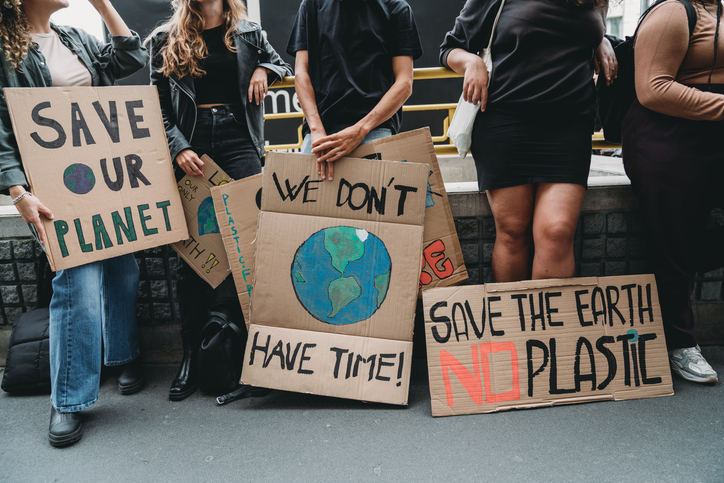Young People Are Worried About Climate Change—and That’s Affecting Their Future Plans
Nearly 70% of those surveyed say environmental concerns may affect career choice, while others say it’s a factor in decisions about having children
More than four in five young Americans are worried about the impact of climate change on people and the planet, according to a survey of nearly 16,000 youths published in Lancet Planetary Health on Thursday. Most respondents do not believe governments are doing enough to reduce emissions, and a majority are looking to the corporate sector to make big changes.
As this group of 16- to 25-year-olds enters the workforce, there’s some indication those feelings will affect big life decisions such as where to live, whether to have kids and what to do for work: 64% of respondents said they “strongly agree,” “agree” or “somewhat agree” that climate change will impact their plans for the future.
“We certainly can see that climate is causing a lot of distress,” said Eric Lewandowski, associate professor at New York University’s medical school and lead researcher on the study. He said this is the first survey of its kind that focuses on the U.S., and the largest his team is aware of. A global survey conducted in 2021 found similar levels of climate-related stress among youths around the world.
The study also examined links between experience of severe weather events and attitudes about climate change. The researchers found that regardless of political affiliation, people who said they had experienced severe weather events were more likely to report feeling worried about climate change. Just under half of respondents said they were “very sure” climate change is happening, and a further 20% were “moderately sure.”
“Being anxious about climate disruption is a legitimate response to a real threat,” said Lise Van Susteren, associate professor at George Washington University and researcher on the study. A co-founder of the Climate Psychiatry Alliance, a group that helps therapists support patients with environment-related anxiety, Van Susteren said the survey results confirmed what she has seen on the ground, but the numbers were more severe than she expected.
It’s still not clear whether feelings about climate change transfer into broader labor force trends. While 67% of respondents said they may choose to work for employers who show commitments to sustainability and reducing their climate impact, recruiters who work on hiring entry-level candidates for oil and gas jobs say they haven’t heard much about climate concerns, said Keith Wolf, Houston-based managing partner of staffing firm Murray Resources.
Wolf informally polled recruiters on his team, and they said entry-level candidates who expressed hesitancy to work for fossil-fuel companies were outnumbered by those who wanted to break into the field. Some job candidates expressed concerns about other factors affecting the industry, like volatility.
In 2017, Ernst & Young published a survey that found college students were reluctant to pursue jobs in the oil-and-gas industry because they viewed it as “dirty and dangerous,” said Tim Haskell, managing director at the accounting firm.
Since then, he said, employers have updated their talking points. “I think companies saw that message as well as some of their own internal research and have really tried to shift the employee value proposition to say, hey, come here and change the industry from the inside out,” Haskell said.
The Lancet survey found that climate-related concerns about the future extend beyond career choice. More than three-quarters of respondents said the future is frightening, and more than half of respondents agreed that they were hesitant to have children.
 Copyright 2020, Dow Jones & Company, Inc. All Rights Reserved Worldwide. LEARN MORE
Copyright 2020, Dow Jones & Company, Inc. All Rights Reserved Worldwide. LEARN MORE
A divide has opened in the tech job market between those with artificial-intelligence skills and everyone else.
A 30-metre masterpiece unveiled in Monaco brings Lamborghini’s supercar drama to the high seas, powered by 7,600 horsepower and unmistakable Italian design.
A divide has opened in the tech job market between those with artificial-intelligence skills and everyone else.
There has rarely, if ever, been so much tech talent available in the job market. Yet many tech companies say good help is hard to find.
What gives?
U.S. colleges more than doubled the number of computer-science degrees awarded from 2013 to 2022, according to federal data. Then came round after round of layoffs at Google, Meta, Amazon, and others.
The Bureau of Labor Statistics predicts businesses will employ 6% fewer computer programmers in 2034 than they did last year.
All of this should, in theory, mean there is an ample supply of eager, capable engineers ready for hire.
But in their feverish pursuit of artificial-intelligence supremacy, employers say there aren’t enough people with the most in-demand skills. The few perceived as AI savants can command multimillion-dollar pay packages. On a second tier of AI savvy, workers can rake in close to $1 million a year .
Landing a job is tough for most everyone else.
Frustrated job seekers contend businesses could expand the AI talent pipeline with a little imagination. The argument is companies should accept that relatively few people have AI-specific experience because the technology is so new. They ought to focus on identifying candidates with transferable skills and let those people learn on the job.
Often, though, companies seem to hold out for dream candidates with deep backgrounds in machine learning. Many AI-related roles go unfilled for weeks or months—or get taken off job boards only to be reposted soon after.
Playing a different game
It is difficult to define what makes an AI all-star, but I’m sorry to report that it’s probably not whatever you’re doing.
Maybe you’re learning how to work more efficiently with the aid of ChatGPT and its robotic brethren. Perhaps you’re taking one of those innumerable AI certificate courses.
You might as well be playing pickup basketball at your local YMCA in hopes of being signed by the Los Angeles Lakers. The AI minds that companies truly covet are almost as rare as professional athletes.
“We’re talking about hundreds of people in the world, at the most,” says Cristóbal Valenzuela, chief executive of Runway, which makes AI image and video tools.
He describes it like this: Picture an AI model as a machine with 1,000 dials. The goal is to train the machine to detect patterns and predict outcomes. To do this, you have to feed it reams of data and know which dials to adjust—and by how much.
The universe of people with the right touch is confined to those with uncanny intuition, genius-level smarts or the foresight (possibly luck) to go into AI many years ago, before it was all the rage.
As a venture-backed startup with about 120 employees, Runway doesn’t necessarily vie with Silicon Valley giants for the AI job market’s version of LeBron James. But when I spoke with Valenzuela recently, his company was advertising base salaries of up to $440,000 for an engineering manager and $490,000 for a director of machine learning.
A job listing like one of these might attract 2,000 applicants in a week, Valenzuela says, and there is a decent chance he won’t pick any of them. A lot of people who claim to be AI literate merely produce “workslop”—generic, low-quality material. He spends a lot of time reading academic journals and browsing GitHub portfolios, and recruiting people whose work impresses him.
In addition to an uncommon skill set, companies trying to win in the hypercompetitive AI arena are scouting for commitment bordering on fanaticism .
Daniel Park is seeking three new members for his nine-person startup. He says he will wait a year or longer if that’s what it takes to fill roles with advertised base salaries of up to $500,000.
He’s looking for “prodigies” willing to work seven days a week. Much of the team lives together in a six-bedroom house in San Francisco.
If this sounds like a lonely existence, Park’s team members may be able to solve their own problem. His company, Pickle, aims to develop personalised AI companions akin to Tony Stark’s Jarvis in “Iron Man.”
Overlooked
James Strawn wasn’t an AI early adopter, and the father of two teenagers doesn’t want to sacrifice his personal life for a job. He is beginning to wonder whether there is still a place for people like him in the tech sector.
He was laid off over the summer after 25 years at Adobe , where he was a senior software quality-assurance engineer. Strawn, 55, started as a contractor and recalls his hiring as a leap of faith by the company.
He had been an artist and graphic designer. The managers who interviewed him figured he could use that background to help make Illustrator and other Adobe software more user-friendly.
Looking for work now, he doesn’t see the same willingness by companies to take a chance on someone whose résumé isn’t a perfect match to the job description. He’s had one interview since his layoff.
“I always thought my years of experience at a high-profile company would at least be enough to get me interviews where I could explain how I could contribute,” says Strawn, who is taking foundational AI courses. “It’s just not like that.”
The trouble for people starting out in AI—whether recent grads or job switchers like Strawn—is that companies see them as a dime a dozen.
“There’s this AI arms race, and the fact of the matter is entry-level people aren’t going to help you win it,” says Matt Massucci, CEO of the tech recruiting firm Hirewell. “There’s this concept of the 10x engineer—the one engineer who can do the work of 10. That’s what companies are really leaning into and paying for.”
He adds that companies can automate some low-level engineering tasks, which frees up more money to throw at high-end talent.
It’s a dynamic that creates a few handsomely paid haves and a lot more have-nots.
ABC Bullion has launched a pioneering investment product that allows Australians to draw regular cashflow from their precious metal holdings.
A 30-metre masterpiece unveiled in Monaco brings Lamborghini’s supercar drama to the high seas, powered by 7,600 horsepower and unmistakable Italian design.





















